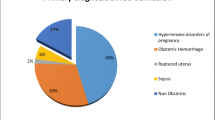Abstract
Background
Critical value reporting has been widely adopted by hospitals throughout the world, but there were few reports about neonatal critical values. This study aimed to analyze characteristics of the neonatal critical values considered at our center and to provide information on improving neonatal intensive care.
Methods
A retrospective study of critical values at a newborn tertiary center in China was conducted to assess neonatal critical values according to test, distribution, reporting time, patient outcome and the impact to the therapy.
Results
In total, 926 critical values were recorded. Overall, 66.52% (616/926) of the items were reported within 24 hours of admission, 50.28% (465/926) during duty times and 54.75% (507/926) in the neonatal intensive care unit (NICU). The routine coagulation test was the most frequent source of critical values. Electrocardiography, blood gas analysis and therapeutic drug monitoring of drug levels were associated with the highest rates of treatment intervention (100%); routine coagulation tests were the lowest (23.14%). Sample quality was the main cause of false-positive critical values.
Conclusions
The incidence of neonatal critical values peaked during the first 24 hours post-admission and during duty periods. Each newborn center needs to enact rapid treatment guidelines to address common critical values in order to facilitate clinical interventions. Periodically reviewing critical values could help to optimize clinical practices.
Similar content being viewed by others
References
Lundberg GD. Critical (panic) value notification: an established laboratory practice policy (parameter). JAMA 1990;263:709.
Yang D, Zhou Y, Yang C. Analysis of laboratory repeat critical values at a large tertiary teaching hospital in china. PLoS One 2013;8:e59518.
Pai M, Moffat KA, Plumhoff E, Hayward CP. Critical values in the coagulation laboratory: results of a survey of the North American Specialized Coagulation Laboratory Association. Am J Clin Pathol 2011;136:836–841.
AWARE TARE. Medical laboratories—Particular requirements for quality and competence. INTERNATIONAL ORGANIZATION 2011;2011:06–06. Available: http://www.iso.org (accessed May 2, 2012).
Geaghan SM. Critical values for the maternal-fetal unit, fetus, infant, child and adolescent: bilirubin reporting practice in North American Children’s Hospitals as a paradigm for critical value reporting assessment. Clin Biochem 2011;44:483–484.
Dighe AS, Rao A, Coakley AB, Lewandrowski KB. Analysis of laboratory critical value reporting at a large academic medical center. Am J Clin Pathol 2006;125:758–764.
Howanitz PJ, Steindel SJ, Heard NV. Laboratory critical values policies and procedures: a college of American Pathologists Q-Probes Study in 623 institutions. Arch Pathol Lab Med 2002;126:663–669.
Lundberg GD. It is time to extend the laboratory critical (panic) value system to include vital values. MedGenMed 2007;9:20.
Gong Y, Adeli K. A national survey on pediatric critical values used in clinical laboratories across Canada. Clin Biochem 2009;42:1610–1615.
Jenkins JJ, Mac Crawford J, Bissell MG. Studying Critical Values Adverse Event Identification Following a Critical Laboratory Values Study at the Ohio State University Medical Center. American journal of clinical pathology 2007;128:604–609.
Agarwal R, Chhillar N, Tripathi CB. Study of variables affecting critical value notification in a laboratory catering to tertiary care hospital. Indian J Clin Biochem 2015;30:89–93.
Don-Wauchope AC, Wang L, Grey V. Pediatric critical values: laboratory-pediatrician discourse. Clin Biochem 2009;42:1658–1661.
Patra S, Mukherjee B, Sahoo S. An analysis of critical value system in tertiary care hospitals in Bhubaneswar, Odisha. Int J Bioassays 2013;2:430–432.
Adamkin DH. Postnatal glucose homeostasis in late-preterm and term infants. Pediatrics 2011;127:575–579.
Dweck HS. Neonatal hypoglycemia and hyperglycemia: two unique perinatal metabolic problems. Postgrad Med 1976;60:118–124.
Codner E, Flanagan SE, Ugarte F, Garcia H, Vidal T, Ellard S, et al. Sulfonylurea treatment in young children with neonatal diabetes: dealing with hyperglycemia, hypoglycemia, and sick days. Diabetes Care 2007;30:e28-e29.
Bialkowski J, Koehler M. Hyperglycemia in newborn infants. II. Secondary hyperglycemia in the neonatal period. Endokrynol Pol 1989;40:89–93. [In Polish]
Ramel SE, Long JD, Gray H, Durrwachter-Erno K, Demerath EW, Rao R. Neonatal hyperglycemia and diminished long-term growth in very low birth weight preterm infants. J Perinatol 2013;33:882–886.
van der Lugt NM, Smits-Wintjens VE, van Zwieten PH, Walther FJ. Short and long term outcome of neonatal hyperglycemia in very preterm infants: a retrospective follow-up study. BMC Pediatr 2010;10:52.
Kao LS, Morris BH, Lally KP, Stewart CD, Huseby V, Kennedy KA. Hyperglycemia and morbidity and mortality in extremely low birth weight infants. J Perinatol 2006;26:730–736.
Lippi G, Plebani M, Di Somma S, Cervellin G. Hemolyzed specimens: a major challenge for emergency departments and clinical laboratories. Crit Rev Clin Lab Sci 2011;48:143–153.
Heyer NJ, Derzon JH, Winges L, Shaw C, Mass D, Snyder SR, et al. Effectiveness of practices to reduce blood sample hemolysis in EDs: a laboratory medicine best practices systematic review and meta-analysis. Clin Biochem 2012;45:1012–1032.
Goyal A, Spertus JA, Gosch K, Venkitachalam L, Jones PG, Van den Berghe G, et al. Serum potassium levels and mortality in acute myocardial infarction. JAMA 2012;307:157–164.
Aher S, Malwatkar K, Kadam S. Neonatal anemia. Semin Fetal Neonatal Med 2008;13:239–247.
Dighe AS, Jones JB, Parham S, Lewandrowski KB. Survey of critical value reporting and reduction of false-positive critical value results. Arch Pathol Lab Med 2008;132:1666–1671.
Snyder SR, Favoretto AM, Baetz RA, Derzon JH, Madison BM, Mass D, et al. Effectiveness of practices to reduce blood culture contamination: a Laboratory Medicine Best Practices systematic review and meta-analysis. Clin Biochem 2012;45:999–1011.
Author information
Authors and Affiliations
Corresponding author
Rights and permissions
About this article
Cite this article
Wang, ZL., Du, LZ., Chen, YY. et al. Analysis of the characteristics and management of critical values in a newborn tertiary center in China. World J Pediatr 13, 49–56 (2017). https://doi.org/10.1007/s12519-016-0058-2
Received:
Accepted:
Published:
Issue Date:
DOI: https://doi.org/10.1007/s12519-016-0058-2




